WIND Lecture 3 Global Wind Circulation
0.0(0)
Card Sorting
1/91
Earn XP
Description and Tags
Study Analytics
Name | Mastery | Learn | Test | Matching | Spaced |
|---|
No study sessions yet.
92 Terms
1
New cards
What is atmospheric stability? What happens when the air is stable/unstable?
Its an indication of how easily a parcel of air is lifted. If the air is very stable it is difficult to make the parcel rise. If the air is very unstable the parcel rises on its own once started.
2
New cards
What is atmospheric stability?
The reason for looking at air parcels is to help determine the stability of the atmosphere.
3
New cards
What is the air pocket/bubble? What size is it?
An air pocket/bubble has no definite size, retains shape and characteristics rising/sinking through atmosphere
4
New cards
What is the difference between stable and unstable atmosphere?
Stable Atmosphere - rising parcel becomes cooler than surrounding environment slowing/ending its rise.
Unstable Atmosphere - temperature of the parcel is higher than the surrounding environment
Unstable Atmosphere - temperature of the parcel is higher than the surrounding environment
5
New cards
What is Air Parcel Density?
Density differences between a parcel and its surroundings are determined by their temperatures.
Air that is denser than its surroundings sinks.
Air that is less dense than its surroundings floats upward.
Air that is denser than its surroundings sinks.
Air that is less dense than its surroundings floats upward.
6
New cards
When atmosphere is unstable/stable is it positive/negative energy?
Temperature of the rising parcel decreases to less than
the surrounding atmosphere
•Due to its cooling the parcel becomes denser than the
surrounding environment
•Gravity slows or even reverses its rise
•Atmosphere is 'STABLE’ - NEGATIVE ENERGY
Temperature of the rising parcel remains higher than
the surrounding atmosphere (despite its cooling)
•The parcel, less dense than the surrounding environment
continues to rise
•Atmosphere is 'UNSTABLE’ - POSITIVE ENERGY
the surrounding atmosphere
•Due to its cooling the parcel becomes denser than the
surrounding environment
•Gravity slows or even reverses its rise
•Atmosphere is 'STABLE’ - NEGATIVE ENERGY
Temperature of the rising parcel remains higher than
the surrounding atmosphere (despite its cooling)
•The parcel, less dense than the surrounding environment
continues to rise
•Atmosphere is 'UNSTABLE’ - POSITIVE ENERGY
7
New cards
What is the difference between positive and negative buoyancy?
Positive buoyancy - When a parcel of air is less dense
than the surrounding air and floats upward.
Negative buoyancy – air parcel that is colder than the
surrounding air will be denser and will have negative
buoyancy.
than the surrounding air and floats upward.
Negative buoyancy – air parcel that is colder than the
surrounding air will be denser and will have negative
buoyancy.
8
New cards
Define Adiabatic
Temperature change without heat exchange between the air inside and outside of parcel
9
New cards
Define Condensation
Process by which water vapor in the air changes into liquid water
10
New cards
Define Adiabatic Process
Temperature change caused by the expansion (cooling) or compression (warming) of a body of air as it rises or descends in the atmosphere.
11
New cards
Define Lapse Rate
The rate of temperature decrease with the increase in altitude.
12
New cards
At what rate does unsaturated air cool (dry adiabatic lapse rate)
Unsaturated air always cools at a rate of 10 degrees/km
13
New cards
At what rate does saturated air cool (moist adiabatic lapse rate)
Saturated air cools at a rate of 6 degrees/km
14
New cards
What releases when saturated air rises, expands and cools?
Condensation releases latent heat inside the parcel.
15
New cards
Why does latent heat energy reduce the cooling?
Latent heat energy offsets and reduces the cooling due to expansion.
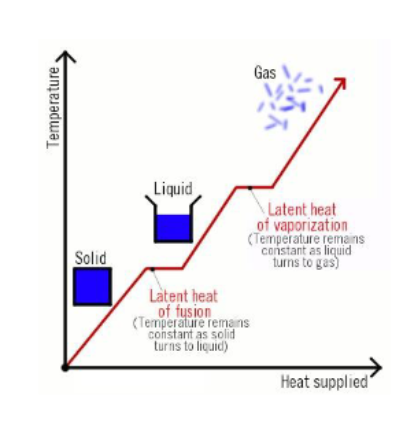
16
New cards
What are the two types of energy that is released or absorbed in the atmosphere?
Latent and sensible heat
17
New cards
What is latent heat?
Latent heat is related to changes in phase between liquids, gases, and solids.
18
New cards
What is sensible heat?
Sensible heat is related to changes in temperature of a gas or object with no change in phase.
19
New cards
What is adiabatic cooling?
Adiabatic cooling is associated with elevation and with cooling as air rises it will expand and cool. The temperature change that occurs without heat being added or taken away is called adiabatic.
20
New cards
What is adiabatic heating?
The adiabatic heating results when a cooler, less dense air mass sinks and compresses.
21
New cards
What makes air rise?
Heating from below,
Coasts and hills,
Convergence,
And Weather Fronts
Coasts and hills,
Convergence,
And Weather Fronts
22
New cards
Heating from below
If air is located over a surface which is warmer that is is, it will be heated by the surface. This will make it less dense, and it will start to rise.
23
New cards
Coasts and Hills
Physical barriers to airflow will force air to rise over them.
24
New cards
Convergence
If two air flows meet from different directions, then one may be forced to rise over the other
25
New cards
Weather fronts
Rising air is associated with weather fronts
26
New cards
What is the reason for the existence of areas of high and low surface pressure?
Mass of the atmosphere is not uniformly distributed across Earth’s surface creating large areas of high and low surface pressure
Pressure differences set the air in motion causing wind
Wind patterns – very much related to pressure patterns
Pressure differences set the air in motion causing wind
Wind patterns – very much related to pressure patterns
27
New cards
Air Convergence?
Rising air cool -> cooling leads to condensation -> condensation produces clouds
28
New cards
How does air convergence happen?
Northern hemisphere at the surface - low pressure systems have a counterclockwise rotation.
Wind turns slightly inward towards the lowest pressure
• Air converges at the center of the low near the ground
• Having nowhere to go the converging air rises
• As the air rises, the water vapor within cools and eventually condenses into cloud droplets/raindrops
• Low pressure centers are generally associated with clouds, precipitation, i.e. "bad weather"
Wind turns slightly inward towards the lowest pressure
• Air converges at the center of the low near the ground
• Having nowhere to go the converging air rises
• As the air rises, the water vapor within cools and eventually condenses into cloud droplets/raindrops
• Low pressure centers are generally associated with clouds, precipitation, i.e. "bad weather"

29
New cards
How does Air Divergence happen?
Northern Hemisphere - surface high pressure systems
have a clockwise rotation
• Wind turns slightly outward away from the highest pressure
• Air diverges from the center of the high near the ground
• Air from above to fills in the void left by the diverging
air at the surface
• Sinking motion in the center of a high pressure system
• High pressure systems are associated with "good
weather"
have a clockwise rotation
• Wind turns slightly outward away from the highest pressure
• Air diverges from the center of the high near the ground
• Air from above to fills in the void left by the diverging
air at the surface
• Sinking motion in the center of a high pressure system
• High pressure systems are associated with "good
weather"
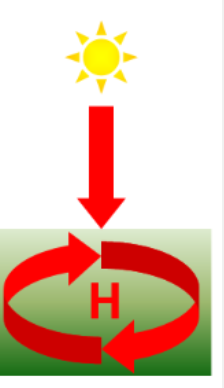
30
New cards
Convergence and Divergence Aloft
Air that is forced to rise due to convergence at the surface low eventually diverges aloft
•Air above cyclone diverges (spreads out)
Air converges aloft above the surface high and sinks to replace the diverging air at the surface
•Air above anticyclone converges (comes together)
•Air above cyclone diverges (spreads out)
Air converges aloft above the surface high and sinks to replace the diverging air at the surface
•Air above anticyclone converges (comes together)
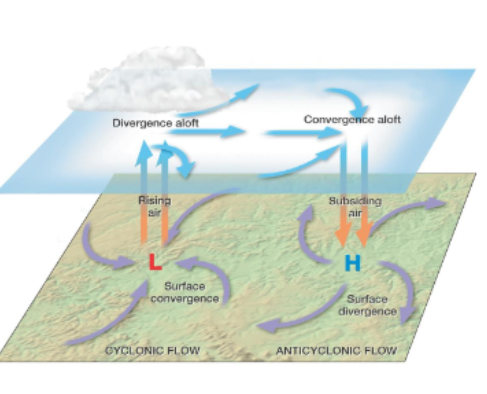
31
New cards
What is the size and life span of global atmospheric motion? Example?
Size: 2500-25 000 km
Life span: weeks or longer
Ex. Intertropical Convergence Zone
Life span: weeks or longer
Ex. Intertropical Convergence Zone
32
New cards
What is the size and life span of synoptic atmospheric motion? Example?
Size: 1000-5000 km
Life span: Days
Ex. Cyclones
Life span: Days
Ex. Cyclones
33
New cards
What is the size and life span of mesoscale atmospheric motion? Example?
Size: 2-2000 km
Life span: Minutes to hours
Ex. Thunderstorms
Life span: Minutes to hours
Ex. Thunderstorms
34
New cards
What is the size and life span of molecular atmospheric motion? Example?
Size: unidentified
Life span: microseconds to milliseconds
Ex. Heat conduction, molecular dispersion
Life span: microseconds to milliseconds
Ex. Heat conduction, molecular dispersion
35
New cards
What are synoptic scale events?
Features or weather events that cover hundreds or thousands of km2
•Cyclones/Depression
Hurricanes
Midlatitude Cyclones
•Anticyclones
•Supercell thunderstorms
•Tornadoes (mesoscale)
•Cyclones/Depression
Hurricanes
Midlatitude Cyclones
•Anticyclones
•Supercell thunderstorms
•Tornadoes (mesoscale)
36
New cards
Difference between high pressure and low pressure
look at image
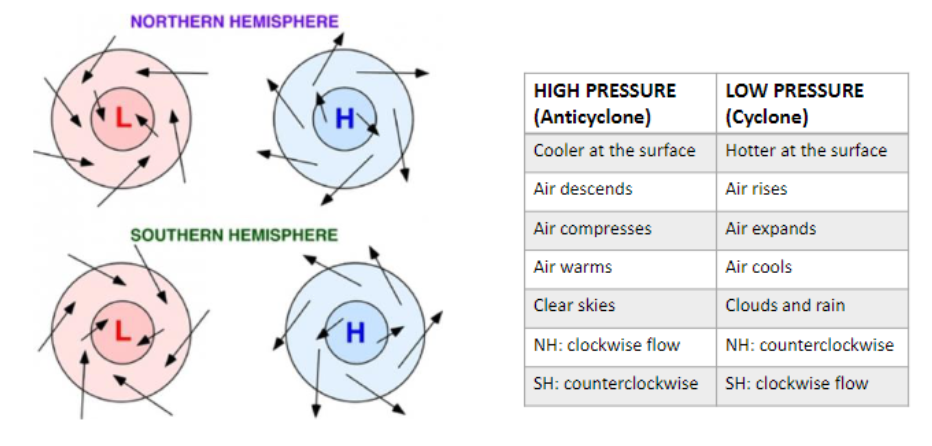
37
New cards
What are anticyclones?
An anticyclone, or a ‘high’ can be identified on a weather chart as an often large area of widely spaced isobars, where pressure is higher than surrounding areas
• In the Northern Hemisphere winds blow in a clockwise direction around high pressure areas
• The highest pressure occurs at the center and is known as the ‘high pressure center’
• In the Northern Hemisphere winds blow in a clockwise direction around high pressure areas
• The highest pressure occurs at the center and is known as the ‘high pressure center’
38
New cards
What are cyclones/depressions?
A depression, or a ‘low’ can be recognized on a weather chart by an area of closely spaced isobars, often in a roughly circular shape, where pressure is lower than surrounding areas
• In the Northern Hemisphere winds blow around depressions in an anticlockwise direction
• The lowest pressure occurs at the middle of a depression, known as the ‘low pressure center’
• In the Northern Hemisphere winds blow around depressions in an anticlockwise direction
• The lowest pressure occurs at the middle of a depression, known as the ‘low pressure center’
39
New cards
What are sea and land breezes and where do they occur?
Sea and land breezes occur near the shores of large lakes.
Sea breeze - Sea to land
Land breeze - Land to sea
Sea breeze front: Clouds
- boundary between the cool, stable sea-breeze flow and the hot, unstable winds over land.
Sea breeze - Sea to land
Land breeze - Land to sea
Sea breeze front: Clouds
- boundary between the cool, stable sea-breeze flow and the hot, unstable winds over land.
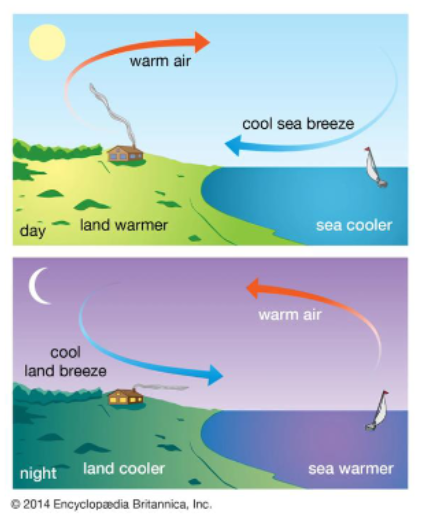
40
New cards
During the day, does the beach or the sea heat up quicker?
A beach heats up faster than the ocean. Air rises as it heats over the beach. Air over the ocean is colder. Wind moves from the higher pressure over the ocean to the lower pressure over land to create a sea breeze.
41
New cards
During the night, does the beach or the sea heat up quicker?
At night, the process reverses, the beach cools off quickly. The ocean stays warmer and air rises over the ocean creating low pressure. The air moves from the higher pressure over land toward the ocean to create a land breeze.
42
New cards
Define Monsoon
refers to the seasonal reversal in atmospheric low-level circulations
43
New cards
What is the Asian monsoon circulation?
Monsoon – seasonal change in wind direction. It is the strongest and largest monsoon that occur in Asia
•May to September – winds are poleward
•November to March – winds are equatorward
•May to September – winds are poleward
•November to March – winds are equatorward
44
New cards
How do monsoons occur?
Monsoon is associated with a dramatic increase in summer precipitation, mostly in the form
of thunderstorms. The basic forcing is derived from a seasonal contrast in the heating of the land continent vs.
the ocean
It is also present over many regions of the globe
of thunderstorms. The basic forcing is derived from a seasonal contrast in the heating of the land continent vs.
the ocean
It is also present over many regions of the globe
45
New cards
What is the monsoon wind system?
Pattern of wet summers and dry winters - surface winds and associated precipitation
• Monsoon circulation scale – once considered to be regional
• Monsoon circulation - important component of the large-scale global circulation
• Monsoon circulation scale – once considered to be regional
• Monsoon circulation - important component of the large-scale global circulation
46
New cards
Monsoon Development Mechanism
47
New cards
Monsoon Development Mechanism
48
New cards
What are the three types of mountain winds?
- Valley Breeze
- Mountain breeze
- Katabatic Wind
- Mountain breeze
- Katabatic Wind
49
New cards
What are valley breezes?
Slopes of mountains heat up quickly on hot summer
afternoons. The air rises creating localized low pressure. Air from the cooler valley moves upslope causing a Valley Breeze.
afternoons. The air rises creating localized low pressure. Air from the cooler valley moves upslope causing a Valley Breeze.
50
New cards
What are mountain breezes?
At night, the Sun dips below the mountains and the mountains and the mountain top cools very quickly. The wind reverses and causes a Mountain breeze.
51
New cards
What is the katabatic, Faehn, and fall wind?
Downslope wind, gravity wind that is caused by gravitational flow of cooler air from higher surrounding terrain
Faehn - Katabatic wind formed by compression during descent into denser air
Fall Wind - A large-scale katabatic wind that descends too rapidly to warm
Faehn - Katabatic wind formed by compression during descent into denser air
Fall Wind - A large-scale katabatic wind that descends too rapidly to warm
52
New cards
What is glacier wind?
A type of katabatic wind that occurs in high latitude regions that develops over a glacier or a snow field located on high terrain
•Cold air is generated over frozen terrain continually
•Winds are affected day/night and there are choppy seas near glaciers
•Cold air is generated over frozen terrain continually
•Winds are affected day/night and there are choppy seas near glaciers
53
New cards
What is the general circulation of the atmosphere?
The general circulation of the atmosphere refers to the mean global flow over a long enough period to remove variations caused by weather systems but short enough to capture seasonal and monthly variability.
54
New cards
What are the major influences on the general circulation of the atmosphere?
• Differential heating
• Rotation of the planet
• Topography
• Atmospheric and oceanic fluid dynamics
• Rotation of the planet
• Topography
• Atmospheric and oceanic fluid dynamics
55
New cards
What is differential heating? What happens at high latitudes?
At the equator, rays strike the Earth almost perpendicular to its surface, warming up a small area
At high latitudes, the curve of the Earth causes rays to strike a larger surface area, so the same amount of heat is distributed over a larger area.
At high latitudes, the curve of the Earth causes rays to strike a larger surface area, so the same amount of heat is distributed over a larger area.
56
New cards
What is poleward energy transport? What is the atmosphere primarily responsible for?
Atmosphere is primarily responsible for the energy transport that compensates for the net radiation imbalances. For the ocean, the energy transport is heat transport.
57
New cards
Where is more energy released in? Polar regions or sun?
There is more energy released in the polar regions than is received by the Sun.
58
New cards
What is the Earth's Revolution around the sun?
The Earth revolves around the Sun in an elliptical orbit such that it is closest to the Sun on January 4th and farthest away on July 5th
59
New cards
What is the incoming solar radiation received at the top of the atmosphere?
Around 3.4% greater than when the Earth is farthest away. (this difference is not very noticeable at the Earth's surface due to the dominance of mesoscale and synoptic-scale factors).
60
New cards
What is the Earth's tilt at?
Earth's axis is tilted at 23.5 degrees. Its orientation changes constantly as it orbits the Sun causing the seasons.
61
New cards
What are the three levels that create global-scale climate drivers?
The drivers that create weather and climate exist on three levels:
- Global-scale
- Synoptic-scale
- Mesoscale
- Global-scale
- Synoptic-scale
- Mesoscale
62
New cards
What is global-scale climate drivers?
It occurs on scales from 1000s of km to planetary motions and include:
- The tilt of the Earth
- Earths revolution around the Sun
- The distribution of land and water on the planet
- Latitude
- The tilt of the Earth
- Earths revolution around the Sun
- The distribution of land and water on the planet
- Latitude
63
New cards
What is synoptic-scale climate drivers?
Occurs on scales from a few 100s km to 1000s of km and include:
• Wave patterns
• Air masses
• Fronts
• Jet streams
• Moisture flows
• Diurnal cycles
• Rising and sinking air
• Ocean currents
• Vorticity patterns
• Distributions of different types of
terrain (land/sea)
• Wave patterns
• Air masses
• Fronts
• Jet streams
• Moisture flows
• Diurnal cycles
• Rising and sinking air
• Ocean currents
• Vorticity patterns
• Distributions of different types of
terrain (land/sea)
64
New cards
What is mesoscale climate drivers?
Occurs on scales from km to a few 100 km and include:
• Interactions between different types of terrain
• Locally dominant winds (upslope/downslope winds)
• Other anomalies such as the Urban Heat Island (UHI) effect
• Interactions between different types of terrain
• Locally dominant winds (upslope/downslope winds)
• Other anomalies such as the Urban Heat Island (UHI) effect
65
New cards
What is the one cell theory (Hadley cell)?
One giant vertically overturning cell in each hemisphere. The energy is transported as sensible and latent heat. Latent heat transport occurs when moist equatorial air moves poleward, cools, condenses and releases latent heat.
66
New cards
What happens in Hadley cell circulation?
Warm air is rising and cold air is
sinking. The excess heating at the equator is transported poleward by rising warm air. Rising warm air is replaced by cold sinking polar air moving equatorward.
sinking. The excess heating at the equator is transported poleward by rising warm air. Rising warm air is replaced by cold sinking polar air moving equatorward.
67
New cards
What are the assumptions that are made with the Hadley cell?
The earth is entirely covered with water
• (exclusion of land-sea interactions)
There are no seasons and the sun is always shining directly over the equator
• (exclusion of seasonal wind shifts)
• No Coriolis force
• (exclusion of land-sea interactions)
There are no seasons and the sun is always shining directly over the equator
• (exclusion of seasonal wind shifts)
• No Coriolis force
68
New cards
What are some problems associated with the one cell model?
• Rotation introduces the Coriolis effect, and must be
considered for explaining the wind flow at different
latitudes
• Tilt causes seasonality, which can’t be explained with
one cell of wind (energy) circulation
• Continentality causes land / sea variation due to
varying thermal inertia
• Land and water have different heat capacities
considered for explaining the wind flow at different
latitudes
• Tilt causes seasonality, which can’t be explained with
one cell of wind (energy) circulation
• Continentality causes land / sea variation due to
varying thermal inertia
• Land and water have different heat capacities
69
New cards
What is the three cell model?
If we allow for the effects of a rotating planet, the simple
single-cell model breaks down into multiple cells in
each hemisphere.
Instead of redistributed heat by one massive Hadley cell
from the equator to the poles, there are now three
convective cells.
The three cell model has an equator of 30 degrees latitude. The air rises at equator, moves poleward and sinks at 30 degrees north and 30 degrees south. The poles have high pressure systems and the equator has a large belt of low pressure along it. The COOL AIR RISES. AND WARM AIR SINKS.
Surface winds travel north and under the influence of Coriolis force veer to the east.
single-cell model breaks down into multiple cells in
each hemisphere.
Instead of redistributed heat by one massive Hadley cell
from the equator to the poles, there are now three
convective cells.
The three cell model has an equator of 30 degrees latitude. The air rises at equator, moves poleward and sinks at 30 degrees north and 30 degrees south. The poles have high pressure systems and the equator has a large belt of low pressure along it. The COOL AIR RISES. AND WARM AIR SINKS.
Surface winds travel north and under the influence of Coriolis force veer to the east.
70
New cards
What are the discrepancies with the three-cell model?
•Much of the upper-level winds in the midlatitudes in reality are westerly like the surface, while the Ferrel cell suggests there should be easterly winds aloft
•Model is roughly accurate for surface winds and provides a really good first order pattern for general circulation
•Model is roughly accurate for surface winds and provides a really good first order pattern for general circulation
71
New cards
What is seasonality?
Seasonal distribution of the solar flux of energy. Seasonal shifts in climate conditions.
72
New cards
What is continentality?
A measure of the difference between continental and marine climates.
Characterized by the increased range of temperatures over land compared with water
Land surfaces – much lower heat capacities
Land masses heat and cool faster than water
Friction (air - land) > Friction (air – water)
Characterized by the increased range of temperatures over land compared with water
Land surfaces – much lower heat capacities
Land masses heat and cool faster than water
Friction (air - land) > Friction (air – water)
73
New cards
What is semi-permanent pressure cells?
•The three-cell model provides a good start for description of general distribution of wind and pressure
•The real world is not covered by a series of belts
•Instead, we find a number of alternating semi-permanent cells of high and low pressure
•Semi-permanent pressure cells undergo seasonal changes in position and intensity over the course of the year
•Some of these cells result from temperature differences, other from dynamical processes (related to the atmospheric motion)
•The real world is not covered by a series of belts
•Instead, we find a number of alternating semi-permanent cells of high and low pressure
•Semi-permanent pressure cells undergo seasonal changes in position and intensity over the course of the year
•Some of these cells result from temperature differences, other from dynamical processes (related to the atmospheric motion)
74
New cards
What are the areas of rising and sinking vertical air that set up the semi permanent pressure zones?
• Sub-Tropical High Pressure cells (STHPs)
• Inter-Tropical Convergence Zone (ITCZ)
• Sub-Polar Lows
• Inter-Tropical Convergence Zone (ITCZ)
• Sub-Polar Lows
75
New cards
What are the areas with Semi-permanent high and semi-permanent lows with low and high pressure systems?
•Bermuda – Azores High
•Pacific High
•Icelandic Low
•Aleutian Low
•Pacific High
•Icelandic Low
•Aleutian Low
76
New cards
What is the upper level flow?
Critically important principles in understanding the distribution of wind and pressure in the upper atmosphere:
•Pressure decreases more rapidly with altitude where the air is cold
•Temperature in the lower troposphere generally decreases from the subtropics to the polar regions
•Pressure decreases more rapidly with altitude where the air is cold
•Temperature in the lower troposphere generally decreases from the subtropics to the polar regions
77
New cards
What are jet streams?
It's a swift flowing current of air that is 1000s of km long, a few 100s km wide and a few km thick. It is 10-15 km above the surface. The speed ranges from 150-300 km/h. The jets occur at the divisions of the 3 cells.
78
New cards
What is the effect jet streams have on airplane flying?
The prevailing wind in the jet stream explains why airplane flights from the east coast to the west coast often take slightly longer than flights from the west coast to the east coast.
Pilots will attempt to take advantage of the jet stream to save time and fuel consumption
Pilots will attempt to take advantage of the jet stream to save time and fuel consumption
79
New cards
What is polar jet?
For midlatitude regions the polar jet is more important than the subtropical jet
If we are experiencing very cold weather, the polar jet stream is to the south of us, and vice versa during a winter thaw
Surface features, such as low pressure systems (storms),
tend to follow the direction of the upper level jet stream
If we are experiencing very cold weather, the polar jet stream is to the south of us, and vice versa during a winter thaw
Surface features, such as low pressure systems (storms),
tend to follow the direction of the upper level jet stream
80
New cards
What are air masses?
Air masses are large, relatively uniform “blocks” of air that have taken on the characteristics of the underlying surface. The combination of land and water on Earth's surface leads to the regional production of air masses
with differing characteristics.
with differing characteristics.
81
New cards
What are the major bands of horizontal winds that direct the movement of air masses?
• Polar easterlies
• Midlatitude prevailing westerlies
• Easterly trades of the tropics
-> Northeasterly trades
-> Southeasterly trades
• Midlatitude prevailing westerlies
• Easterly trades of the tropics
-> Northeasterly trades
-> Southeasterly trades
82
New cards
What is the difference between ocean air mass and continental air mass?
Ocean air masses tend to be wet while continental air masses tend to be dry. Drier air masses tend to heat and cool more quickly. Both ocean and continental air masses
can be warm or cold. Air masses are not static. They undergo moisture and temperature changes when they leave their source regions.
can be warm or cold. Air masses are not static. They undergo moisture and temperature changes when they leave their source regions.
83
New cards
How do you classify air masses?
The characteristics of an air mass are represented by a
two-letter classification scheme that describes the
general temperature and moisture characteristics of
its place of origin.
The first letter indicates moisture characteristics:
• “m” for maritime (moist and mild)
• “c” for continental, meaning that the air mass has been over land long enough that it is relatively dry and modified more strongly by daytime heating and cooling
The second letter indicates temperature characteristics:
• “E” for equatorial (hot)
• “T” for tropical (hot)
• “P” for polar (cold to warm)
• “A” for Arctic (very cold)
ex. cP - continental Polar
two-letter classification scheme that describes the
general temperature and moisture characteristics of
its place of origin.
The first letter indicates moisture characteristics:
• “m” for maritime (moist and mild)
• “c” for continental, meaning that the air mass has been over land long enough that it is relatively dry and modified more strongly by daytime heating and cooling
The second letter indicates temperature characteristics:
• “E” for equatorial (hot)
• “T” for tropical (hot)
• “P” for polar (cold to warm)
• “A” for Arctic (very cold)
ex. cP - continental Polar
84
New cards
What are stratospheric winds?
These winds circulate the planet over roughly a two-year period in alternating easterly and westerly directions. They're estimated from satellites. Winds at these high levels are assumed to be geostrophic.
In midlatitudes in winter they have a westerly component.
In midlatitudes in summer they have an easterly component.
In midlatitudes in winter they have a westerly component.
In midlatitudes in summer they have an easterly component.
85
New cards
What is the Brewer-Dobson circulation?
BDC refers to the global atmospheric circulation pattern in tropical troposphere
•Air raises into the stratosphere and then moves poleward as it descends.
•Air raises into the stratosphere and then moves poleward as it descends.
86
New cards
What is the Brewer-Dobson circulation impact globally?
Circulation directly impacts the distribution and abundance of stratospheric ozone by moving it from the tropics towards the poles. This transport helps to explain why tropical air has less ozone than polar air, even though the tropical stratosphere is where most atmospheric ozone is produced
87
New cards
What is the ozone hole?
Each year for the past few decades during the Southern Hemisphere spring, chemical reactions involving chlorine and bromine cause ozone in the southern polar region to be destroyed rapidly and severely. This depleted region is known as the “ozone hole”.
88
New cards
What is the Quasi-Biennial Oscillation (QBO)
Regular variation of the winds that blow high above the equator. Strong winds in the stratosphere travel in a belt around the planet. Every 14 month these winds completely change directions. Full cycle takes 28 month. The most regular slow variation in the atmosphere after the cycle of seasons.
89
New cards
Why is the Quasi-Biennial Oscillation (QBO) important?
It affects jet stream. The speed of winds in the jet
stream weaken and strengthen with the direction of the QBO. When QBO is easterly –chance of a weak jet stream causing colder winters in Northern Europe. When QBO is westerly – chance of a strong jet stream causing mild
winters, winter storms and heavy rainfall.
stream weaken and strengthen with the direction of the QBO. When QBO is easterly –chance of a weak jet stream causing colder winters in Northern Europe. When QBO is westerly – chance of a strong jet stream causing mild
winters, winter storms and heavy rainfall.
90
New cards
What is the El Nino (ex of atmosphere-ocean circulation)
Climate pattern that describes the unusual warming of surface waters in the eastern tropical Pacific
Ocean
El Niño – warm phase of the El Niño-Southern Oscillation
impacts trade winds and the atmosphere.
Ocean
El Niño – warm phase of the El Niño-Southern Oscillation
impacts trade winds and the atmosphere.
91
New cards
What is the walker circulation?
Conceptual model of air flow in the tropics in the troposphere. Caused by the pressure gradient force that results from a high pressure system over the Pacific and low pressure system over Indonesia. During El Niño conditions, the WC causes easterly trade winds that
move warmed water/air to the West.
move warmed water/air to the West.
92
New cards
When does the El Nino get strong?
When the trade winds weaken, the warm water mass from the western equatorial Pacific slides back to the eastern equatorial Pacific
The movement of this warm water mass also changes the locations of evaporation and precipitation along the equator
The western part, normally very wet, experiences droughts during an El Niño and the eastern region, normally very dry, experiences heavy rains
The movement of this warm water mass also changes the locations of evaporation and precipitation along the equator
The western part, normally very wet, experiences droughts during an El Niño and the eastern region, normally very dry, experiences heavy rains